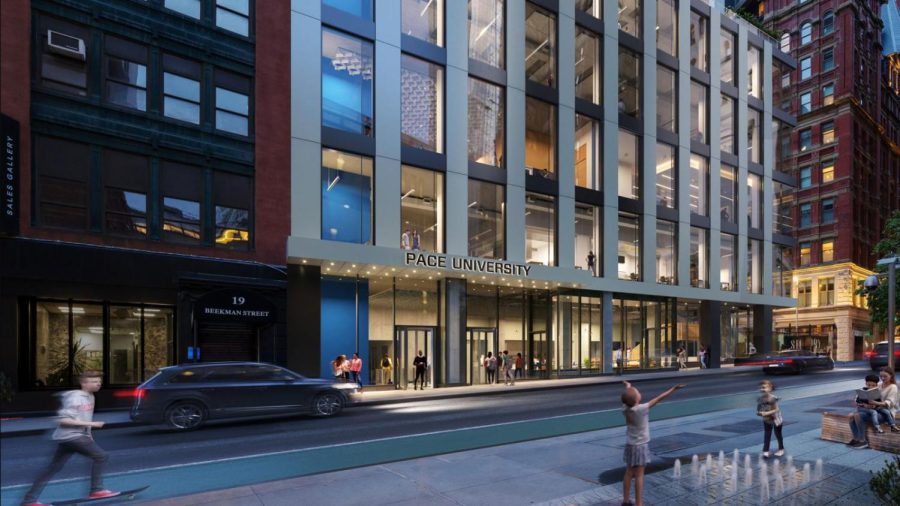University enters final months of 15 Beekman and One Pace Plaza East Renovation projects
April 20, 2023
The University is nearing the end of its four-phased multi-million dollar capital development project, with Phase Three: 15 Beekman projected to be completed by August 2023 and Phase Four: One Pace Plaza East anticipated by January 2026.
According to Wayne Chen, the Director of Campus Planning, Phase One updated One Pace Plaza West and the first three floors of 41 Park Row–the basement and first and second floors. The most significant changes are noticeable at the main entrance of One Pace Plaza and the main circulation, which includes the student centers and the connection between the East and West Wing through the courtyard. Phase Two consisted of reconstructing One Pace Place Plaza West floors four, five and six for the Lubin School of Business.
Phase Three is currently underway at 15 Beekman, which required the University to sign a long-term lease agreement to occupy the building, working closely with a developer to construct a completely University-immersed building from the ground up.
Phase Four will begin with the decommissioning of One Pace Plaza East is estimated to begin as early as September and demolition in October, at which point no access will be granted to the East Wing until renovations are complete.
The academic section of 15 Beekman will cost $56.75 million, funded by a segregated Construction Fund, according to Robert Almon, the CFO and University’s Executive Vice President of Finance & Administration. However, it’s important to note that financing 15 Beekman and One Pace Plaza East is subject to change if circumstances shift.
One Pace Plaza East will cost $255 million (including the Maria’s Tower reconstruction), $30 million of which has been secured through grants from the State and Federal governments, Almon confirmed. The University plans to “announce a substantial gift from a donor as a part of a border fundraising campaign,” he explained. $65 million is expected to be funded by the University’s internal resources, for which $23 million is already isolated in the Construction Fund, with the remainder being financed with the proceeds of a bond issue.
In partnership with FXCollaborative, a Brooklyn-based award-winning architecture firm, the University’s Architecture Research Office conducted a Town Hall on March 24 in the Student Center to present renderings of 15 Beekman and the final schematic design of One Pace Plaza East.
Austin Sakong, FXCollaborative’s Design Director of Cultural and Educational Studio, led the Town Hall and expressed that the University’s mantra “Opportunitas” was essential when creating the Master Plan of the University’s four-phased reconstruction.
According to the University’s website, 15 Beekman will utilize 103,000 gross square footage (GSF) across the lower eleven floors and 94,000 GSF for student residential housing and amenities on the upper thirteen floors. “While the building shares a single public entry, the ground floor has been designed with discreet elevator lobbies for accessing the residential part of the building and the academic portion of the building,” reads the University’s website.
The library’s circulation desk and group study room can be found on the fourth floor, leading up to the fifth floor, where students will find approximately 50,000 volumes of books and five enclosed study rooms that can be reserved. The new library will replace the Birnbaum Library, which is being reconfigured into a Medium Venue, or black box theater, as part of the One Pace Plaza East renovation.
The sixth floor is reserved for the cafeteria and outdoor terrace and the seventh floor will be the new learning commons for peer tutoring. Floors nine, 10 and 11 will be the new home of the Seidenberg School of Information Systems and Computer Science, with state-of-the-art design factors that can support events like hackathons.
According to Chen, to address concerns regarding fall protection or self-inflicting harm, University Campus Planning and Facilities will be installing code-compliant eight-foot tall railings along the terrace in conjunction with security cameras for maximum safety.
Floors 13 to 25 will house the newest residence hall with suite-style living. Most suite configurations will be a 10-person unit (two doubles and two triples) where students will share two bathrooms and a common area.
“Residential life understands the need to monitor and to be prepared to adapt as needed to any changes in how roommate and suitemate conflicts develop,” said Patrick Roger-Gordon, the Assistant Dean of Students and University Director of Housing Operations. “They are currently reviewing and updating their training plans for Residence Directors and Resident Assistants to ensure that they are prepared to manage any shift in the way our students experience conflict.”
“Residential Life, Security and Housing Operations [will] always work to respond to safety concerns brought forth by students, including student staff members, but no concerns whatsoever have been brought forth by anyone on the RA staff,” Roger-Gordon assured.
Roger-Gordon also expressed that this is not the first time the University has had multi-student suites, as virtually all first-year students on the Pleasantville campus live in five-person suites. “Our NYC Residential Life Staff will no doubt learn a lot from their partners in Pleasantville, who have had years of experience in managing students in suites,” he stipulated.
The heart of the One Pace Plaza East project lies in the three performing arts theaters. The Schimmel Center Theater will be converted into a proscenium theater that Sakong said will closely resemble that of a Broadway stage and seating arrangement. The new Schimmel will also feature a dressing room and green room anchored to the east wing. Cafe 101 will be replaced with a Medium Venue black box theater that will seat approximately 160 to 180 people. Another Small Venue black box will be housed on the second floor with 99 seats, next to a Screening Room.
The East Wing will be tricked out for the Art Department, including an animation studio and a post-production lab, alongside design and light labs and entertainment spaces on the cellar level. The upper level will feature a large dance rehearsal studio overlooking the courtyard.
“The renovation is a total gut renovation. So the whole building is getting reshuffled. There will be a new floor plate demolition of the existing floor plate. Everything’s changing,” said Chen. He also assured that the asbestos fireproofing used in the existing structure throughout the entire East side of One Pace Plaza would be abated in an organized manner and be replaced with asbestos-free spray-on fireproofing.
Dyson College of Arts and Sciences has identified the need to build 12 faculty offices that the University’s Campus Planning and Facilities is looking to design and build this summer. Displaced professors whose offices are located in the East Wing will be relocated to the second floor of One Pace Plaza West, where the dance studio currently resides.
Laurie Brown Kindred, the Performing Arts Assistant Director of Finance and Facilities, Production Manager and Performing Arts Professor, confirmed that the new Performing Arts studio spaces in One Pace Plaza East would not be open to non-performing arts majors or student organizations and will primarily serve performing arts majors due to the projected demand.
“Many of these spaces replace PPA spaces that have been taken away over the years and/or space that is rented not only for academics but also production lab work,” said Kindred.
Additionally, the University intends to remove Pace Sustainability Initiative’s garden, which currently provides the University’s food pantry with fresh produce, leaving students and professors worried about the continual perpetuation of food insecurity on campus. According to Ryan McEnany, the University’s Director of Energy and Resiliency, the garden will “remain in place into October [2023] to allow for a harvest this year.” The future location of the garden is currently being assessed and will be studied during the design development phase of the One Pace Plaza project.
According to documents obtained by the University’s Campus Planning and Facilities, 15 Beekman’s sustainability strategy is comprised of four main goals: “Carbon emission reductions through a high-performance building envelope; Incorporating biophilic design at the exterior planted terrace spaces for occupant wellness; Extensive daylighting at open podium floors; and Selection of sustainable furniture, fixtures and equipment (FFE), low emitting furniture and flow fixtures.”
Most notably, the University is pursuing an NYC Zoning and Energy Conservation program entitled Zone Green, which will increase “allowable floor area in exchange for high-performance building envelopes,” according to the 15 Beekman Sustainability Strategy Sheet. The University’s Office of Energy and Resiliency calculated that compliance with Zone Green would save the University approximately $1.25 million in electrical and natural gas consumption over the next 25 years. Reducing carbon costs is also estimated to save the University $500,00 over 25 years.
The University will implement a range of sustainable strategies into 15 Beekman, including but not limited to energy-efficient LED lights, increased insulation, installation of energy-efficient heat pumps, efficient HVAC equipment, biophilic design for the interior and rooftop terrace aimed to benefit mental health, kitchen waste management to be composted offsite and bi-polar ionization to increase indoor air quality.
With these strategies implemented across 15 Beekman, the focus is not only “on sustainable design of new buildings and renovations, but also making sure that the operations of these buildings is also sustainable,” according to Ryan McEnany, the University’s Director of Energy and Resiliency. “It is important to note that throughout the planning process, we have been focused on making sure this building will be energy efficient and exceed the requirements set forth by NYC’s Local Law 97 [of 2019].”
McEnany attended the U.S. Department of Energy’s (DoE) Better Buildings Summit in Washington D.C. where the University won the “Better Practice Award,” which recognized the University for being an innovative industry leader in decarbonization, energy and water efficiency or waste reduction. According to McEnany, the University is the first in the nation to receive such an honor.
The University’s Campus Planning and Facilities encourages students, professors and faculty to contact [email protected] to continue the discussion and informal dialogue regarding the 15 Beekman and One Pace Plaza construction as they are currently and will be actively seeking feedback even after renovations are complete.












